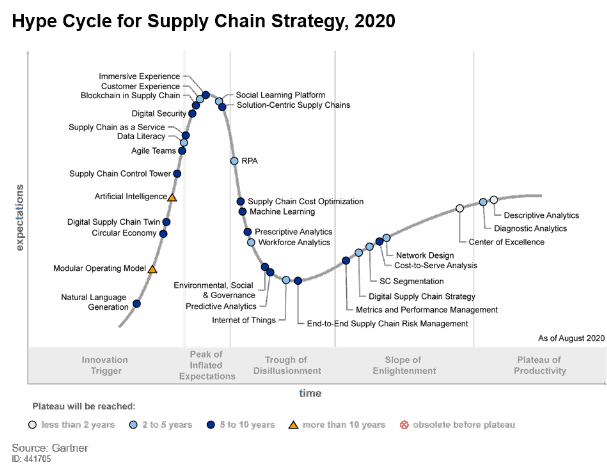Gartner, the global research and advisory firm, has released its Hype Cycle for Supply Chain Strategy, 2020 report showing that Internet of Things (IoT) applications have reached a low point known as the trough of disillusionment.
“Companies have gotten past the hype; they know what IoT is and how it works,” Mike Burkett, vice president and analyst with the Gartner Supply Chain Practice, told FreightWaves. “Now they are just trying to figure out where to use it. That’s why it’s in the trough.”
The widely cited Gartner Hype Cycle describes the level of maturity, adoption and business benefits associated with technologies that have the potential to transform industries. The five evocatively named stages of the cycle are innovation trigger, peak of inflated expectations, trough of disillusionment, slope of enlightenment and plateau of productivity.
The trough of disillusionment highlights technologies and markets in which interest has waned as experiments and implementations have failed to deliver.

Trucking ahead of the curve
Gartner’s latest report aggregates usage of different supply chain technologies across industries: consumer packaging, life sciences, transportation and logistics, manufacturing and others.
Burkett, responding to FreightWaves’ inquiry, said trucking and transportation are a little farther along in the IoT hype cycle, with OEMs and service providers like Samsara and FourKites using embedded sensor data to track everything from fuel use to engine health to the location of the item being shipped.
Elaborating on those applications, he noted that fleet management and asset-tracking technology is moving to a point where the industry can predict events and not just react — for example, notifying fleet managers ahead of time when a truck might need service.
As a result, logistics IoT is “further up the curve plateau of predictability,” Burkett explained.
AMR behind the curve
He highlighted the use of IoT in another transformational technology in the logistics sector, autonomous mobile robots (AMR) — robots that can navigate their environment without human intervention.
Sensors embedded in autonomous robots send information about various data points, such as location and maintenance status, to a software platform that can optimize their behavior.
While adoption of IoT in autonomous mobile robots is farther along in the hype cycle, according to Burkett, the actual use of autonomous robots is not. Instead, AMRs register closer to the peak of inflated expectations, a stage in which early publicity yields success stories that are nevertheless accompanied by “scores of failures.”
Climbing out of the trough
Overall, the IoT market will begin to pull out of the abyss in the next few years, the Gartner report states, as the technology advances and practitioners succeed in defining the best opportunities for the unique measurement and tracking capabilities of IoT.
The firm estimates that installed units for manufacturing and natural resources industries are forecast to grow to 1.9 billion in 2028. That is five times from 331.5 million units in 2018.
Supply chain leaders should work with subject matter experts to identify processes that can benefit from IoT technology, Burkett said. “It’s not that it doesn’t work, and it’s not that it isn’t very helpful. It’s: ‘Do the majority of companies know how to use it?’”
Burkett said if the expert is a third-party provider, supply chain companies should be sure to check how they might use – and monetize – the captured data.
Related stories:
Mobile robots feed warehouse demand for adaptability
Report: Warehouse robotics investment surges 57% in 2020
Bayer, Kimberly-Clark showcase FourKites’ visibility solutions









IoT app development company
IoT can help industries perform tasks like overseeing the quality of a manufactured product, documenting actual product performance, creating early warning and detection signals, enabling closed-loop feedback to drive quality improvements in future products, and so on. Hakuna Matata solution as an experienced IoT app development company builds applications that satisfy your requirement.
Tim Higham
Maybe the VC’s will bow start funding those entities that actually have proven business models, profits, actual real customers, and a path to market domination. 😜🤣👍. The market has spoken (as it always does)!!!!